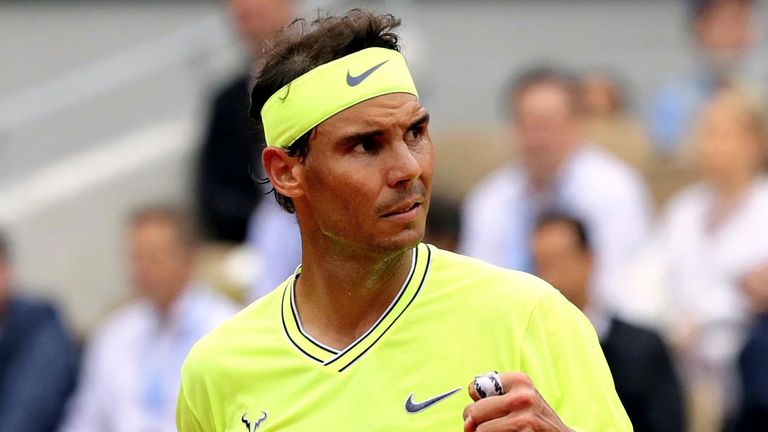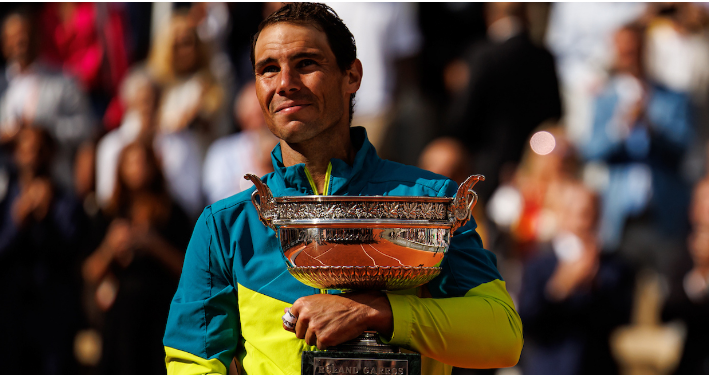Tuesday morning saw an Olympics landmark for the ages, at least for all the tennis nuts among the audience: the 60th matchup between Rafael Nadal and Novak Djokovic, two legends and longtime nemeses facing off on the Olympic stage yet again. Maybe we were watching Nadal for the last time ever, some fans wondered, though Nadal himself scoffed at the prospect at a press conference: “Who said it was last dance?”
The faceoff went about as expected, with the top-ranked, slightly younger Serbian earning a decisive victory over his Spanish rival, making the pair’s total head-to-head record 31–29 in Djokovic’s favor. Still, Nadal played a valiant second set, making Djokovic hustle for his win and keeping the score close enough that the final result, at least for a bit, did not appear a foregone conclusion. And Nadal still had a few more games in Paris left, advancing with fellow Spaniard and burgeoning star Carlos Alcaraz up through the Men’s Doubles quarterfinals on Wednesday … in which they lost to Rajeev Ram and Austin Krajicek of Team USA, ending Nadal’s competitive chances in Paris 2024 and, likely, his Olympic career. At the very Games where he bore the torch, no less.
It was a tearful moment for fans of Rafa, who packed the seats at Stade Roland Garros for their hero’s comeback tour—he’s the French Open record-holder, the all-time king of clay, after all—and spiritedly booed both Djokovic and Nadalcaraz’s formidable doubles opponents. Nadal took a moment, himself, to linger on the court after his doubles downfall and wave at the adoring crowd, in an arena where he’d dominated so many times before, though he just couldn’t pull it off here.
The question that continues to hound Nadal since he bore the torch is whether this, indeed, is his last dance. Following the Djoko loss, Nadal seemed a bit irritated when the Spanish sports show Carrusel Deportivo asked him whether this defeat would be “key in terms of how long you will continue playing,” replying somewhat brusquely in his mother tongue:
Honestly, when I know when I’m going to retire, I’ll tell you. Every day I come here to answer whether it’s my last game or not. I can’t spend every day analyzing whether it could be my last game or not. What can I say? It’s not easy to play in this situation. I try to play, look ahead, and when I’m done here, it will be decided what I really want to do. In some way I’ve earned the right to say it and finish the way I want. When the time comes, I’ll let you know. In the end, I try to do my best. I’ve given myself some time after two difficult years, with many problems, and I’ve given myself that time to see if I’m capable of improving. If I’m not capable, I’ll make decisions. But I can’t live with this every day, answering every day whether I’m going to retire or not. It seems like every day you want to retire me. Give me a little more time.
One could view this as a statement of defiance from a veteran with nothing left to prove, a former world No. 1 in his sport and the winner of two Olympic gold medals for his home country. Yet it also came off, in the moment, as something deeply sad—a plea, almost, for the viewers to stop undercutting him so publicly, at this point in his decadeslong professional career, at a moment of recovery and reemergence.
After the doubles loss, Rafa admitted that “this was not the end we wished for.” He added that his “most important goal” for the year had been to get just one more gold for Spain, and that in the wake of the clearly deflating setback, he was going to think things over—although he was hardly committing to retirement. “My next step is to go home, spend time with family, disconnect for months,” he told Spanish media. “It’s exciting that I have returned to playing tennis, but it’s also hard because I have gone through many, many difficult moments, disappointments, but also beautiful moments.”
2024 certainly hasn’t been Nadal’s best year. This was just one more round on his comeback tour, following a yearslong spate of routs in the Grand Slams—the Australian Open, French Open, Wimbledon, and U.S. Open—and physical injuries that kept hobbling his performance and forced him to withdraw from various events last year, causing his ranking to plummet within the Association of Tennis Professionals. As this year’s season took off, he faced even more defeats and injuries—at the Brisbane International, at the first round of the French Open, and even at the inaugural “Netflix Slam,” which offered a real nail-biter against none other than Alcaraz.
But the spirit and excitement of Nadal’s play, the passion he always brings to tennis, couldn’t keep him down for long. He made the final at the Swedish Open, and brought on a solid couple Olympics matches as doubles partner with Alcaraz. The volleys, the slices, the sprints across the clay, the fortitude of a long-running match—it was all there as Nadalcaraz respectively faced off against the Argentine and Dutch doubles pairs, locking their opponents into endless back-and-forths, into the closest set scores and ties possible, exuding a thrilling on-court presence. The Spanish duo’s highlights against the Netherlands’ Tallon Griekspoor and Wesley Koolhof are testament. Rafa asserts his control at both the net and the back court, countering his opponents’ hits with ease, whimsy, and grace. At his best, as ever, he does not resemble a player who’s been struggling to match his former glory.
Watching great athletes age is always hard. Especially ones like Nadal, whose power and vitality were some of his defining qualities, and who was once himself the troublemaking youthful upstart supplanting gods like Roger Federer. To see him struggle in these public venues, even on his career’s holy ground of Roland Garros, perceptive enough to realize what he still has left yet well aware of what he’s now unable to do, is a painful reckoning to witness. It feels cruel, and maybe the cruelest thing is that it’s only the natural way of things, where all great athletes and fans alike end up: older, frailer, less able to compete with the younger generation.
Nadal is older now, many more injuries deep into his career, in professed need of more rest time between matches, and outflanked by younger players who bring a different energy to bear than the Big Three—Rafa, Federer, Djokovic—that defined so much of tennis this century. Alcaraz is a leader in the changing of the guard that’s already begun; after this disappointment, maybe Nadal will be content to rest on his unbelievable laurels, with records and streaks at countless tennis spaces that remain daunting accomplishments. No matter what he does next, he has a legacy that’s earned him widespread adoration and the unbound respect of his most fervent opponents. It’s a melancholy time to be a Nadal fan. But make sure you roll back the tapes, because you can’t fully count him out just yet.


